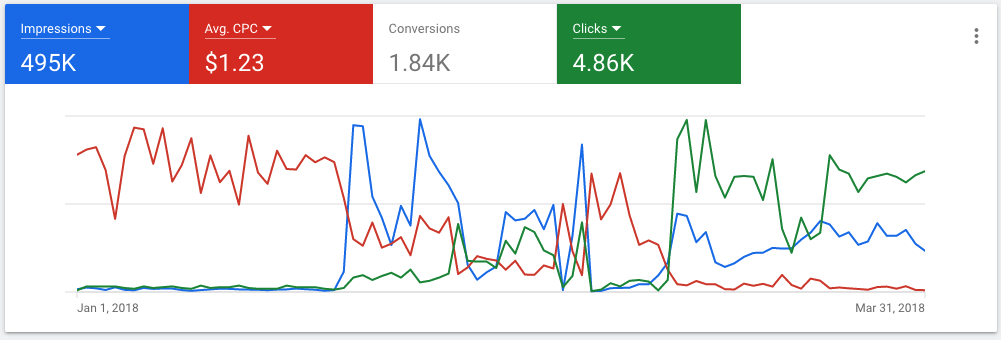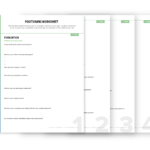Focus on the Positive: B2B Paid Ads Now and After the Pandemic

The Article in 60 Seconds
The math of measuring your return on investments should be simple. Your campaign brought in 10 times what you spent to attract the business, making your ROI 10:1! You and your campaign were a great success!
Unfortunately, the marketing math in measuring the ROI of digital ads is much less linear. Are you measuring your ROI on lead generations or closed deals? Was the current ad campaign solely responsible for getting to the goal line?
Before you can do the math, you need to determine what you’re measuring and how you’re measuring it.
It’s not easy, but 67% of the most successful content marketers are measuring ROI, and you can, too.
In this article, we will help you:
- Set ROI goals
- Figure out your ROI yardstick
Think About This
You’re not the only CMO unsure of how to calculate ROI. Marketing analytics are critical to knowing if your strategies are accomplishing your goals — but many of us don’t know if we’re doing it right.
- Just over 30% of B2B marketers make decisions using marketing analytics. [CMO Survey February 2020]
- While only 43% of top content marketers measure ROI, 59% of them feel they have an excellent/good ability to do so. [B2B Content Marketing 2020]
- Ads still have a place in marketing:
- 49% of people said they click on text ads. [Blue Corona, 2019]
- 63% of people said they’d click on a Google ad. [Search Engine Land, 2019]
Stats During Pandemic
- While the majority of marketers (63%) believe ads will be more important during the pandemic, spending and click-through are dramatically down during the pandemic. [ KoMarketing, 2020 ]
- Facebook reports a 50% increase in messaging, with voice and video calling more than doubling on Messenger and WhatsApp. [ Facebook, 2020 ]
- Ad spend declines up to 50% are expected across all channels, according to advertising professionals. [ Search Engine Watch, 2020 ]
Set Your ROI Goals… for now and for the future
We have identified at least three realities for businesses during the first half of 2020: on fire, evergreen, and on hold. If your business is on hold, we encourage you to fortify your marketing infrastructure right now. One of the ways you can strengthen your team and your tactics is goal setting.
- Set short-term goals for right now, perhaps two weeks at a time.
- Through an understanding of your customer’s adjustments during the pandemic and questions they’ll be asking as they emerge, set goals for the next three months.
- It may be a while before annual goal setting is possible and advisable.
As you move forward, here are the fundamentals for thinking through goals for paid ads.
The most recent CMO Survey says that B2B companies’ marketing ROI has been increasing since 2016, “excelling across profits and sales revenue.”
You can’t afford not to understand exactly how digital ads impact your ROI.
What are your marketing goals for this quarter? Have you determined your key performance indicators (KPIs) for each goal? Are you looking at your scorecard on a regular basis?
No marketing strategy is complete without a set of measurable goals to work toward.
But what should you be measuring? Year-over-year? Increase? Straight count of clicks or conversions?
What you track must reflect the goal for the quarter or the year. A KPI is the numeric value assigned to determine if you are on track for a goal. Take some time to create the measuring stick for your KPIs. A starting place for KPI writing will be your month-over-month or year-over-year statistics, such as planning for an increase of x% over a certain time period. In short, a goal is your destination paired with a deadline.
In addition to including time, consider setting goals around costs (production and promotional) and buyers’ journeys.
Perhaps the focus of your campaign is to attract webinar registrants or content downloads. You might want to see an increase in traffic and/or leads. Consider setting goals for click-through-rates (CTRs), conversion rates, and bounce rates.
A good ROI depends on the kind of campaign you’re managing. Building brand awareness and nurturing campaigns are long games, which does make it harder to track ROI. Engagement goals don’t necessarily correlate to revenue, but with increasing emphasis on recommendations and relationships with trusted partners, every share and like can translate into potential leads.
What does a good ROI look like to you?
Determine How to Measure ROI
The complexity of measuring ROI is the result of integrated marketing campaigns. While the best approaches involve creating content once and using it in multiple marketing avenues to maximize results while minimizing effort, these are the strategies that are more difficult to derive.
Take a look at your ROI goals and then extrapolate what you really want to measure. Some examples are:
- Cost of producing an ad / ad spend
- Cost per click (CPC)
- Visitors
- Conversion rate
- Number of likes or shares
You’re paying someone to write content. Even an in-house person has an internal hourly rate that can be used in calculating ROI. Google Ads, LinkedIn, and even email campaigns all have associated costs.
When investing in social media, display, and pay-per-click ads, your total cost per click can tell you a lot about the effectiveness of your traffic-driving search and social campaigns.
Typically a lower cost per click means a higher-performing campaign.
When setting goals that include measuring visitors, keep in mind that visitors don’t necessarily translate into sales qualified leads (SQLs) or even marketing qualified leads (MQLs). Maybe that’s a ratio you’d like to track. Measuring visitors can add value, as more traffic in general is positive and can lead to building trust and relationships down the road. Just understand what you want to measure so your numbers relate to your goals.
Are your ads converting? Downloads and sign-ups are quantitative numbers, as are email open and bounce rates. Click-throughs and calls-to-action (CTAs) are commonly used for measuring ROI.
Social media
While a Share or a Like is definitely not the same as a download, analyzing your more popular ad campaigns can influence future ad decisions.
Relationships
Use embedded links with UTM strings and bit.ly links that allow you to track with whom your information was shared. Use analytic tracking to show who does what with your content. This allows you to nurture the decision-makers and those that report up who may be part of the decision-making process.
Measure Your ROI
You can concretely track what you’re doing from a paid standpoint. Simply put, you are spending money to create digital assets. Users click on those assets. Users travel through the funnel. Users become customers. It’s straightforward.
Your CRM software probably includes analytical tools to measure campaign attributes.
In HubSpot, for example, you can view ad campaign data after linking to LinkedIn, Google Ads, and Facebook Ads. Use the HubSpot ad dashboard:
HubSpot includes the following metrics and more on tracked campaigns:
- Amount spent
- Campaign type
- CTR
- Clicks
- Cost per contact
Based on data you enter, HubSpot’s CRM can calculate ROI for a paid ad campaign.
Google also offers cost per click for certain keywords using AdWords. Google is reported to have almost 75% of the paid search market. By linking your Google Analytics account to Google Ads, you can gain greater visibility into how your organic and paid efforts are working together—or working against each other.

And most CRMs will integrate with Google Analytics/Google Ads.
Facebook offers analytics, but it’s not a seamless tracking from click to conversion. Dig in and understand what the dashboard is showing you. Remember: trends over time are your best friend. Even though the numbers may feel like comparing apples to hand grenades, watch for the changes within your Facebook profile. That will tell you what’s happening there.

Neil Patel’s blog advises not to forget about phone calls from ads. Yes, kickin’ it old school still has value.
The First Thing to Do After Reading this Article
As noted above, there are two types of goal setting for this season of business: right now, and emerging.
The most recent CMO Survey revealed that CMOs across the board feel that analytics are relevant but remain under-used in decision making. Are you tracking the right analytics? Do you have a scorecard you check each week? You can make better decisions once you know you are gathering and tracking the right data.
Consistently watch for trends and even short bursts. Respond wisely and don’t over-react, but move forward anyway.


